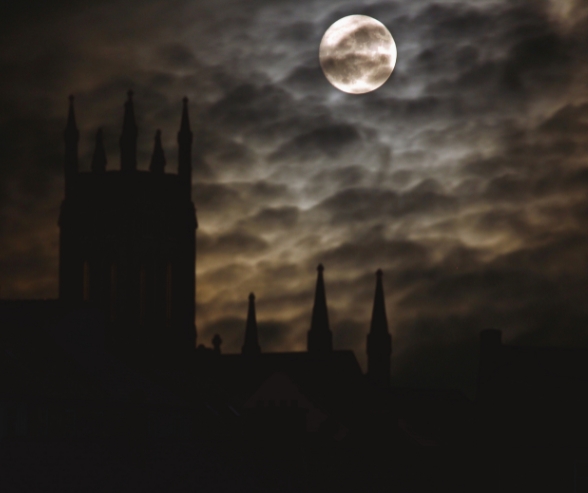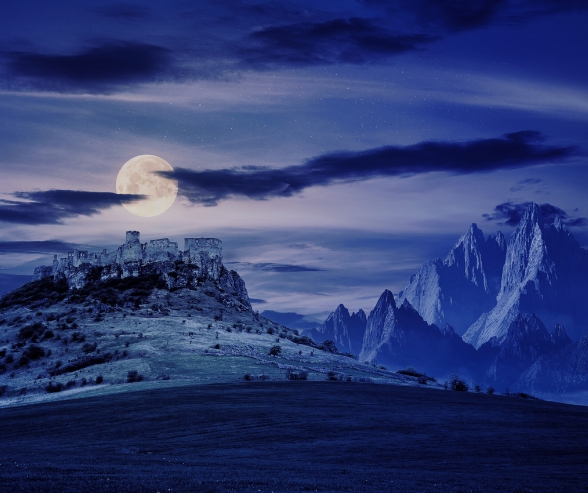Note: This post contains affiliate links to items that you can purchase from Amazon. As an Amazon Associate, I earn from qualifying purchases. Thank you.

It’s my favorite time of year. The time when other places (not Florida) get to enjoy the changing of the seasons, the beautiful colors, and a break from the swelter. But here in Florida, we’ve got to grasp at whatever tangible thing we can to achieve any sense of that cozy feeling I love so much. So in addition to enjoying my favorite spicy and pumpkin-flavored treats and listening to my autumn carols, I am getting super into creepy movies and books. This year, I’ve decided to elevate my reading list from your standard Booktok fare (getting a bit tired of the same old, same old) to classic literature. Follow me back in time through a list of spooky reads from the classics.
- Novels and Stories by Shirley Jackson (1960s): Includes famous stories “The Lottery”, “The Haunting of Hill House”, and “We Have Always Lived in the Castle”, plus many more!
- The Birds and Other Stories by Daphne du Maurier (1940s): The origin of Hitchcock’s famous film, plus five more stories.
- Rebecca by Daphne du Maurier (1938): You’ll never forget the horrible Mrs. Danvers!
- The Old Dark House, a.k.a. Benighted by J. B. Priestley (1927): Three friends get caught in a downpour and have to take shelter in a deteriorating mansion with creepy inhabitants.
- The Trial by Franz Kafka (1925): An average Joe has been arrested and has to defend himself, but he doesn’t even know what the charges are.
- The Haunted Woman by David Lindsay (1922): In an old home, a mysterious staircase is visible to only a few people, and one of them follows it to a room that only exists sometimes, and the events therein are promptly forgotten upon leaving.
- The Witch-Cult in Western Europe by Margaret Alice Murray (1921): This nonfiction anthropological work is responsible for much of the modern-day impressions of witchcraft. Although its findings have been refuted, its impact on culture is still highly relevant.
- The H. P. Lovecraft Collection (1920s): “Lovecraftian” is perhaps my favorite type of horror.
- The Phantom of the Opera by Gaston Leroux (1910): The original story that inspired the famous Broadway musical.
- The Ghost Stories of Edith Wharton (1910s): Ghost stories full of psychological tension, haunted pasts, and the eerie side of high society.
- The Collected Fiction of William Hope Hodgson (1910s): Weird tales that mix supernatural horror with detective fiction and sea creatures and haunted houses.
- The Other Side by Alfred Kubin (1908): A fantasy set in a dreamlike world which becomes a nightmare. The author described it as “a sort of [travel guide] for those lands which are half-known to us”.
- The Bell in the Fog and Other Stories by Gertrude Atherton (1905): Gothic horror mixed with spiritualism, with eerie atmospheres and communication with the dead.
- The Hound of the Baskervilles by Sir Arthur Conan Doyle (1902): A curse and a mystery set among a daunting manor and the misty, eerie moorlands.
- The Purple Cloud by M. P. Shiel (1901): A mysterious purple cloud kills every living creature on Earth except for one man.
- The Complete Supernatural Stories of Algernon Blackwood (1900s): Cosmic horror involving nature as a source of terror.
- The Collected Supernatural and Weird Fiction of W. W. Jacobs (1900s): “The Monkey’s Paw” was not the only terrifying short story by Jacobs. (“The Well” is equally as creepy!)
- The Complete Ghost Stories of M. R. James (1900s): One of the best-known ghost story authors of England.
- The War of the Worlds by H. G. Wells (1898): The quintessential Martian invasion story.
- Dracula by Bram Stoker (1897): The novel all Dracula stories (and Nosferatu) are based on.
- The Invisible Man by H. G. Wells (1897): Not to be confused with Ralph Ellison’s excellent Invisible Man, this one is the supernatural story of a scientist who turns himself literally invisible.
- The Beetle by Richard Marsh (1897): This book frightened people so much, it actually outsold Dracula the year they were released.
- The Island of Dr. Moreau by H. G. Wells (1896): A shipwrecked man is stranded on the mysterious Dr. Moreau’s island and encounters strange creatures and dark secrets.
- The King in Yellow by Robert W. Chambers (1895): A collection of horror stories centered around a mysterious play that drives those who read it to madness.
- The Picture of Dorian Gray by Oscar Wilde (1890): Imagine being blessed with eternal youth and beauty, but your magical portrait changes to reflect every horrible thing you do. You might be slowly driven mad, like Dorian Gray….
- The Great God Pan and Other Horror Stories by Arthur Machen (1890s): Occult horror exploring the thin veil between this world and a terrifying other place.
- The Strange Case of Dr. Jekyll and Mr. Hyde by Robert Louis Stevenson (1886): A terrifying allegory for addiction that presents all sorts of terrifying questions about both the real world and the supernatural. Which character is the true monster–Hyde or Jekyll?
- The Horla and Others by Guy de Maupassant (1880s): Stories dealing with madness, possession, and unseen malevolent beings.
- The Complete Supernatural Stories of F. Marion Crawford (1880s): These stories focus on haunted objects and places, with an emphasis on atmospheric dread.
- The Turn of the Screw and Other Ghost Stories by Henry James (1880s): A collection of psychological horror tales that questions whether its ghosts are real or imagined.
- The Uninhabited House by Charlotte Riddell (1875): Are the secrets that haunt this creepy mansion of this world or another?
- Carmilla by J. Sheridan LeFanu (1872): This sapphic vampire story about a mysterious and creepy but beautiful visitor was one of the inspirations for Dracula.
- The Mystery of Edwin Drood by Charles Dickens (1868): This last novel by Dickens was never finished, so be prepared for the unsolved mysteries of a little English country town with dark secrets.
- Uncle Silas by J. Sheridan LeFanu (1864): A poor little rich orphan is left to the care of her creepy uncle in his creepy house.
- The Woman in White by Wilkie Collins (1862): A man meets an enchanting woman in white on a moonlit night who turns out to have possibly escaped from the nearby insane asylum. From there, we meet a unique assortment of characters, and more weirdness sets in.
- The Man-Wolf by Erckmann Chatrian & Alexandre Chatrian (1859):
- The House of the Seven Gables by Nathaniel Hawthorne (1851): Themes of guilt and generational sin set in a haunted New England house.
- The Tenant of Wildfell Hall by Anne Bronte (1848): A reclusive woman and her son move into the neighborhood and get the wrong sort of attention. What secrets are they hiding?
- Jane Eyre by Charlotte Bronte (1847): When Jane arrives to be governess to Mr. Rochester’s young ward, she falls in love with her handsome employer. But he is concealing some dark secrets inside the house.
- Wuthering Heights by Emily Bronte (1847): A dark story of revenge and passionate love among the moors.
- The Hunchback of Notre-Dame by Victor Hugo (1831): If you thought the Disney movie was dark, check out the novel that inspired it.
- Complete Stories and Poems of Edgar Allan Poe (1830s):
- Melmoth the Wanderer by Charles Maturin (1820): The story of Melmoth, who trades his soul to the devil in order to live forever.
- Frankenstein by Mary Shelley (1818): The book that has inspired countless classic adaptations.
- Northanger Abbey by Jane Austen (1817): The author of Pride and Prejudice goes gothic. I’ve been told before that I’m like Elizabeth Bennett, but let’s be real: I’m Catherine Morland.
- Manfred by Lord Byron (1817): Byron’s self-titled “metaphysical drama” could perhaps be considered a confession of the forbidden love and recent scandal in his own life.
- The Devil’s Elixirs by E. T. A. Hoffmann (1815): This creepy tale by the author of The Nutcracker involves a man stalked by his own doppelganger, who is out for blood.
- Clermont by Regina Maria Roche (1798): A mysterious stranger arrives by night to disrupt the lives of a father and daughter living in seclusion.
- The Midnight Bell by Francis Lathom (1798): An exciting adventure with a gruesome murder, an old castle, a possible haunting, and much more.
- The Orphan of the Rhine by Eleanor Sleath (1798): Creepy castles, secret passageways, and scoundrels abound.
- The Rime of the Ancient Mariner by Samuel Taylor Coleridge (1798): A mariner who has returned from a long voyage at sea recounts his unbelievable tale in verse to an unsuspecting wedding guest.
- The Italian by Ann Radcliffe (1796): A gothic romance full of shocking twists and turns, a moonlit monastery, and a battle between good and evil.
- The Mysterious Warning by Eliza Parsons (1796): An adventure with love, betrayal, dark castles, and ghostly voices.
- The Monk by Matthew Lewis (1796): This book was so shocking and so scandalous when first published that it was banned in England, yet nevertheless read voraciously by young ladies everywhere. You’ll have to read it for yourself to find out why.
- Horrid Mysteries by Carl Grosse (1796): A sort of gothic Casanova.
- The Mysteries of Udolpho by Ann Radcliffe (1794): A heroine is shut up in a castle away from her beloved by her wicked new uncle and finds terrors within.
- The Necromancer, or The Tale of the Black Forest by Karl Friedrich Kahlert (1794): A collection of interconnected creepy stories about a con man pretending (or not?) to be a necromancer.
- The Castle of Wolfenbach by Eliza Parsons (1793): The heroine hides from her creepy uncle inside an abandoned castle where horrible secrets hide.
- The Castle of Otranto by Horace Walpole (1764): Considered to be the first gothic novel.
- The Duchess of Malfi by John Webster (1614): A revenge tragedy about starcrossed lovers and betrayal.
- Macbeth by William Shakespeare (1606): A king is driven to madness after committing murder to gain the throne in this famous “Scottish play” many thespians believe is cursed.
- Doctor Faustus by Christopher Marlowe (1604): Possibly the first written version of the folk legend about a man who sells his soul to the devil.


Leave a Reply